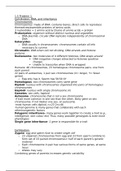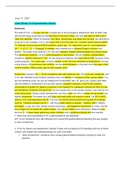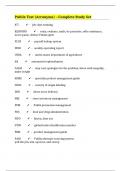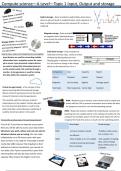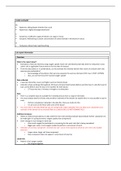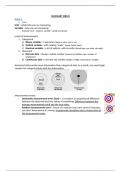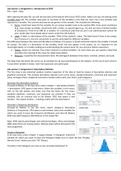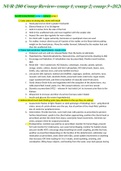1.5 Problem 1
Cell division, DNA, and inheritance
Chromosomes
Chromosomes- made of DNA- contains Genes, direct cells to reproduce
themselves/assemble proteins of amino acids
3 nucleotides = 1 amino acid & Chains of amino acids = protein
Prokaryotes- organism without distinct nucleus and organelles
o DNA plasmid- circular DNA replicate independently of chromosomal
DNA
Eukaryotes-
o DNA usually in chromosomes- chromosomes contain all info
necessary to survive
Chromatin- DNA when cell not dividing, DNA strands and histone
proteins
Nucleosome- two molecules of 4 different histones, DNA wraps around
DNA (negative charge) attracted to histones (positive
charge)
Unable to transcribe when DNA is wrapped
Humans: 46 chromosomes, 23 homologous chromosome pairs- one from
each parent
22 pairs of autosomes, 1 pair sex chromosomes (X= longer, Y= fewer
genes)
o Egg only has X, Sperm has 50:50 XY
Homologous- two chromosomes carry same gene
Diploid- nucleus with chromosomes organised into pairs of homologous
chromosomes
Haploid- nucleus with single chromosome (n)
Gametes- sex cells, haploid
Autosome- chromosome that is not a sex chromosome
-if trait more common in one sex than the other, likely gene on sex
chromosome: if not likelier one sex, on autosome
-most human cells diploid, n=23 2n=46
-human genome is many genes that collaborate with each
other/nongenetic factors
Polygenic inheritance- many genes work together to create a trait (e.g.,
intelligence, skin colour etc) Thus, many possible genotypes & even more
phenotypes
Single gene inheritance- 1 gene is responsible for a trait
Fertilisation
Zygote- egg and sperm fuse to create single cell
o 23 unpaired chromosomes from egg and 23 from sperm combine to
form set of 23 paired chromosomes= half of each parent’s genetic
material
o Each chromosome in pair has various forms of same genes, at same
locus
o Alleles may vary
Combining genes of parents increases genetic variability
, Dizygotic twins (Fraternal) - separate eggs and separate sperm
Monozygotic twins (identical)- single zygote splits, two genetically
identical replicas
Meiosis
Meiosis Mitosis
Two successive cell divisions One cell division
Create sex cells Creates all body cells except sex
Haploid (n) nuclei w. 23 Diploid (2n) nuclei w. 46
chromosomes chromosomes
4 haploid cells develop into 2 identical daughter cells
gametes
Crossing over No crossing over
Daughter cells genetically different Daughter cells genetically identical
Crossing over- in Prophase 1, exchange of genetic material between
non-sister chromatids
2 homologous chromatids break at same point, twist around each
other, connect to other’s initial position
-allows DNA from maternal chromosomes to mix with paternal
chromosomes, so recombinant chromatids are mix of both parents
-promotes genetic variation
Mitosis (M Phase)
Replication of DNA already occurred, chromosomes here= 2 sister
chromatids
Cytokinesis- division of cell into two daughter cells, along metaphase
plate
G2- chromatin condenses via supercoiling (DNA wraps around histones,
produces nucleosomes- nucleosomes wrapped into solenoid- solenoids
group in looped domains- supercoiled into chromosome
Eukaryotic cells- pre-S phase= one DNA molecule
after replication= 2 DNA molecules
Sister Chromatids- two identical molecules held together by
centromere, each molecule= chromatid
Cell division, DNA, and inheritance
Chromosomes
Chromosomes- made of DNA- contains Genes, direct cells to reproduce
themselves/assemble proteins of amino acids
3 nucleotides = 1 amino acid & Chains of amino acids = protein
Prokaryotes- organism without distinct nucleus and organelles
o DNA plasmid- circular DNA replicate independently of chromosomal
DNA
Eukaryotes-
o DNA usually in chromosomes- chromosomes contain all info
necessary to survive
Chromatin- DNA when cell not dividing, DNA strands and histone
proteins
Nucleosome- two molecules of 4 different histones, DNA wraps around
DNA (negative charge) attracted to histones (positive
charge)
Unable to transcribe when DNA is wrapped
Humans: 46 chromosomes, 23 homologous chromosome pairs- one from
each parent
22 pairs of autosomes, 1 pair sex chromosomes (X= longer, Y= fewer
genes)
o Egg only has X, Sperm has 50:50 XY
Homologous- two chromosomes carry same gene
Diploid- nucleus with chromosomes organised into pairs of homologous
chromosomes
Haploid- nucleus with single chromosome (n)
Gametes- sex cells, haploid
Autosome- chromosome that is not a sex chromosome
-if trait more common in one sex than the other, likely gene on sex
chromosome: if not likelier one sex, on autosome
-most human cells diploid, n=23 2n=46
-human genome is many genes that collaborate with each
other/nongenetic factors
Polygenic inheritance- many genes work together to create a trait (e.g.,
intelligence, skin colour etc) Thus, many possible genotypes & even more
phenotypes
Single gene inheritance- 1 gene is responsible for a trait
Fertilisation
Zygote- egg and sperm fuse to create single cell
o 23 unpaired chromosomes from egg and 23 from sperm combine to
form set of 23 paired chromosomes= half of each parent’s genetic
material
o Each chromosome in pair has various forms of same genes, at same
locus
o Alleles may vary
Combining genes of parents increases genetic variability
, Dizygotic twins (Fraternal) - separate eggs and separate sperm
Monozygotic twins (identical)- single zygote splits, two genetically
identical replicas
Meiosis
Meiosis Mitosis
Two successive cell divisions One cell division
Create sex cells Creates all body cells except sex
Haploid (n) nuclei w. 23 Diploid (2n) nuclei w. 46
chromosomes chromosomes
4 haploid cells develop into 2 identical daughter cells
gametes
Crossing over No crossing over
Daughter cells genetically different Daughter cells genetically identical
Crossing over- in Prophase 1, exchange of genetic material between
non-sister chromatids
2 homologous chromatids break at same point, twist around each
other, connect to other’s initial position
-allows DNA from maternal chromosomes to mix with paternal
chromosomes, so recombinant chromatids are mix of both parents
-promotes genetic variation
Mitosis (M Phase)
Replication of DNA already occurred, chromosomes here= 2 sister
chromatids
Cytokinesis- division of cell into two daughter cells, along metaphase
plate
G2- chromatin condenses via supercoiling (DNA wraps around histones,
produces nucleosomes- nucleosomes wrapped into solenoid- solenoids
group in looped domains- supercoiled into chromosome
Eukaryotic cells- pre-S phase= one DNA molecule
after replication= 2 DNA molecules
Sister Chromatids- two identical molecules held together by
centromere, each molecule= chromatid

